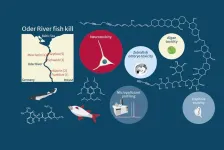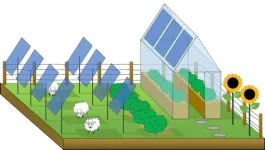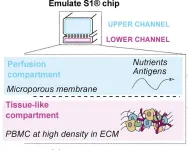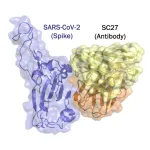(Press-News.org) The U.S. Department of Energy’s (DOE) Office of Science (SC) today announced a new research and development opportunity led by Oak Ridge National Laboratory (ORNL) to advance technologies and drive new capabilities for future supercomputers. This industry research program worth $23 million, called New Frontiers, will initiate partnerships with multiple companies to accelerate the R&D of critical technologies with renewed emphasis on energy efficiency for the next generation of post-exascale computing in the 2029 and beyond time frame.
“There is a growing consensus that urgent action is needed to address an array of bottlenecks in advanced computing, including energy efficiency, advanced memory, interconnects and programmability to maintain economic leadership and national security” said Ceren Susut, Associate Director of the Energy Department’s Office of Science for Advanced Scientific Computing Research. “Through the Exascale Computing Project, we partnered with industry to provide critical advances for the Nation, but much more work remains to be done and the opportunities and challenges of AI underscore the need for continued government investment.”
High-performance computing (HPC) and data-driven modeling and simulation are used extensively to advance DOE science missions and are key investment areas for the Office of Science. In fact, SC is home to three of the top ten fastest supercomputers in the world, all used for open science research, including the world’s first and second fastest systems according to the June 2024 TOP500 list of the world’s most powerful supercomputers. These systems include the 1.206 exaflops HPE Cray EX Frontier at ORNL; the 1.012 exaflops HPE Cray EX- Intel Aurora at Argonne National Laboratory; and the 148.6 petaflops IBM AC922 Summit at ORNL.
But the HPC landscape is changing quickly and evolving. New Frontiers provides an opportunity to address and rapidly adapt to those changes.
“With Dennard scaling long dead and the slowing of Moore’s law, we’re seeing technologies critical to HPC consuming more power that partially offset increases in application performance due to improvements in silicon process nodes and improved packaging techniques,” said Christopher Zimmer, New Frontiers project director. “Current technology trends threaten to have a disruptive and costly impact on the development of DOE applications and potentially a negative impact on the productivity of DOE scientists.”
For technologies targeted for productization in the 5 to 10-year timeframe, industry leaders have noted that processors cannot get faster without producing more heat (Dennard scaling) and computer chips likely cannot get much smaller (Moore’s Law). The New Frontiers project’s strategic R&D investment and innovative vendor engagement opportunities will accelerate development of technologies needed for the next generation of exascale computing within these new realities.
"New Frontiers will be exploring technologies to improve energy efficient computing," said Al Geist, director of the Frontier project. "Energy efficiency is becoming critical to building future generations of Leadership computers and will involve development of new approaches to hardware, software, and application algorithms."
New Frontiers will push strategic advancements in HPC in the exascale era, which will be essential in helping DOE maintain leadership and to address the future challenges in science, energy, health, and growing security threats. The science potential of emerging computing systems and other novel computing architectures will require numerous significant modifications to today’s tools and techniques to deliver on the promise of science.
Through this RFP, the ORNL-led team is soliciting innovative R&D proposals in the areas of hardware technologies, software technologies, and cross-cutting technologies.
Due to the emphasis on extreme-scale application workflows, overall time to solution is also an important consideration. The focus of this program will be on open-source and sustainable software technologies for extreme scale HPC systems and the development of techniques necessary to support emerging workloads of integrated facilities across the DOE landscape.
“New Frontiers comes at a critical moment in high-performance computing,” said Ashley Barker, OLCF program director and Exascale Computing Project deputy director. “We have an exciting opportunity to take advantage of the incredible portfolio of applications and technologies created and enabled by the Exascale Computing Project. With New Frontiers we want to translate those advancements to benefit next-generation systems.”
New Frontiers seeks to fund new and/or accelerated R&D of technologies targeted for productization in the 5 to 10-year timeframe and includes a 40% cost share option. The period of performance for any subcontract resulting from this RFP will be two years.
The RFP is being managed by UT-Battelle LLC, which operates Oak Ridge National Laboratory on behalf of the Department of Energy.
Funding for the RFP is being provided by the DOE Office of Science’s Advanced Scientific Computing Research Program.
The full New Frontiers RFP can be found https://www.olcf.ornl.gov/newfrontiers/.
UT-Battelle manages ORNL for DOE’s Office of Science, the single largest supporter of basic research in the physical sciences in the United States. DOE’s Office of Science is working to address some of the most pressing challenges of our time. For more information, visit energy.gov/science.
END
DOE, ORNL announce opportunity to define the future of high-performance computing
R&D projects will engage vendors for forward-looking technologies and energy efficiencies
2024-09-06
ELSE PRESS RELEASES FROM THIS DATE:
Cannabidiol demonstrated to alleviate symptoms of Leigh syndrome
2024-09-06
A study led by the UAB Institut de Neurociències and published in the journal Nature Communications demonstrates in animal models how daily administration of cannabidiol (CBD), a substance obtained from the cannabis plant, extends lifespan and improves symptoms associated with Leigh syndrome. This severe mitochondrial disease affecting children is characterised by a progressive decline in cognitive and motor functions and premature death. The research group also demonstrated in both mice and fibroblasts from children with ...
A chemical cocktail of micropollutants amplified the effect of algal toxins causing mass fish mortality on the River Oder in 2022
2024-09-06
Summer 2022’s environmental disaster led to the death of up to 60 per cent of fish biomass and up to 85 per cent of mussel and snail biomass in the River Oder. In August 2022, the UFZ set up an interdisciplinary ad hoc working group together with researchers from the Leibniz Institute of Freshwater Ecology and Inland Fisheries (IGB), the University of Veterinary Medicine, Vienna (Vetmeduni) and the University of Birmingham. They took water samples at five locations along the Oder, extracted poisoned ...
Generative AI in cancer imaging: revolutionizing detection & diagnosis
2024-09-06
“This editorial explores its impact on expanding datasets, improving image quality, and enabling predictive oncology.”
BUFFALO, NY- September 6, 2024 – A new editorial was published in Oncotarget's Volume 15 on September 4, 2024, entitled, “Generative AI in oncological imaging: Revolutionizing cancer detection and diagnosis.”
Generative AI is revolutionizing oncological imaging, enhancing cancer detection and diagnosis. This editorial explores its impact on expanding ...
Disparity in access to medications for opioid use disorder persist in criminal legal settings
2024-09-06
EMBARGOED FOR RELEASE UNTIL 11 A.M. ET FRIDAY, SEPTEMBER 6. 2024
Individuals involved in the criminal legal system have a high rate of opioid use disorder (OUD) and a high risk of overdose death compared to the general population, yet the most effective treatments—medications for opioid use disorder (MOUD)—are underutilized in criminal legal settings where treatment is mandated as part of a person’s probation or parole. Medications are often not provided due to stigma or lack of adequate funding for evidence-based care. According to a study ...
Age-related changes in male fibroblasts increase treatment-resistant melanoma
2024-09-06
Age-related changes in the fibroblasts, cells that create the skin’s structure, contribute to the development of aggressive, treatment-resistant melanoma in males, according to research in mice by the Johns Hopkins Kimmel Cancer Center.
The study was published online Sept. 6 in Cell.
The risk of developing melanoma, a potentially deadly skin cancer, increases with age. Men are more at risk than women, and tend to develop more aggressive, hard-to-treat melanomas, particularly at advanced ages, says Ashani Weeraratna, Ph.D., the Bloomberg ...
COVID-19 and rates of cancer diagnosis in the US
2024-09-06
About The Study: This population-based cross-sectional study of U.S. cancer incidence trends found that rates of diagnosis improved in 2021 but continued to be lower than expected, adding to the existing deficit of diagnosed cases from 2020. Particular attention should be directed at strategies to immediately increase cancer screenings to make up lost ground.
Corresponding Author: To contact the corresponding author, Krystle A. Lang Kuhs, PhD, MPH, email krystle.kuhs@uky.edu.
To access the embargoed study: Visit our For The Media website at this link https://media.jamanetwork.com/
(doi:10.1001/jamanetworkopen.2024.32288)
Editor’s Note: Please see ...
New research from Swansea University shines a light on how solar power and farming can coexist
2024-09-06
Scientists from Swansea University have developed a new tool to help identify optimal photovoltaic (PV) materials capable of maximising crop growth while generating solar power.
In a recent study published in Solar RRL, academics from the University’s Department of Physics have been exploring the effect of semi-transparent PV materials placed over crops – an exemplary application of agrivoltaics (solar panels combined with agricultural settings).
As part of this work, the team has developed an innovative freeware tool that predicts the light transmission, absorption, and power generation of different PV materials nearly anywhere on the globe using ...
Artificial lymphoid organs could help predict efficacy of booster vaccines
2024-09-06
Researchers at the Institut Pasteur in France have developed artificial “lymphoid organ-chips” that recreate much of the human immune system’s response to booster vaccines. The technology, described in an article to be published September 6 in the Journal of Experimental Medicine (JEM), could potentially be used to evaluate the likely effectiveness of new protein and mRNA-based booster vaccines for COVID-19 and other infectious diseases.
The rapid mutation and evolution of SARS-CoV-2 and other viruses ...
One antibody to neutralize them all?
2024-09-06
SAN ANTONIO -- A monoclonal antibody appears effective at neutralizing the numerous variants of SARS-CoV-2, as well as related viruses in animals that could pose a threat if they were to begin spreading in people. The antibody, called SC27, was recently described in Cell Reports Medicine.
The finding opens the possibility of broader, more effective treatments to work against current and future COVID variants.
Monoclonal antibody SC27 was identified, developed and provisionally patented by a team of researchers led ...
How context-specific factors control gene activity
2024-09-06
Every cell in our body contains the same DNA, yet liver cells are different from brain cells, and skin cells differ from muscle cells. What determines these differences? It all comes down to gene regulation; essentially how and when genes are turned on and off to meet the cell’s demands. But gene regulation is quite complex, especially because it is itself regulated by other parts of DNA.
Gene regulators: Enhancers, transcription factors
There are two important components that control gene regulation: the first are enhancers, which are short bits of DNA that increase the likelihood that a ...
LAST 30 PRESS RELEASES:
Injectable breast ‘implant’ offers alternative to traditional surgeries
Neuroscientists devise formulas to measure multilingualism
New prostate cancer trial seeks to reduce toxicity without sacrificing efficacy
Geometry shapes life
A CRISPR screen reveals many previously unrecognized genes required for brain development and a new neurodevelopmental disorder
Hot flush treatment has anti-breast cancer activity, study finds
Securing AI systems against growing cybersecurity threats
Longest observation of an active solar region
Why nail-biting, procrastination and other self-sabotaging behaviors are rooted in survival instincts
Regional variations in mechanical properties of porcine leptomeninges
Artificial empathy in therapy and healthcare: advancements in interpersonal interaction technologies
Why some brains switch gears more efficiently than others
UVA’s Jundong Li wins ICDM’S 2025 Tao Li Award for data mining, machine learning
UVA’s low-power, high-performance computer power player Mircea Stan earns National Academy of Inventors fellowship
Not playing by the rules: USU researcher explores filamentous algae dynamics in rivers
Do our body clocks influence our risk of dementia?
Anthropologists offer new evidence of bipedalism in long-debated fossil discovery
Safer receipt paper from wood
Dosage-sensitive genes suggest no whole-genome duplications in ancestral angiosperm
First ancient human herpesvirus genomes document their deep history with humans
Why Some Bacteria Survive Antibiotics and How to Stop Them - New study reveals that bacteria can survive antibiotic treatment through two fundamentally different “shutdown modes”
UCLA study links scar healing to dangerous placenta condition
CHANGE-seq-BE finds off-target changes in the genome from base editors
The Journal of Nuclear Medicine Ahead-of-Print Tip Sheet: January 2, 2026
Delayed or absent first dose of measles, mumps, and rubella vaccination
Trends in US preterm birth rates by household income and race and ethnicity
Study identifies potential biomarker linked to progression and brain inflammation in multiple sclerosis
Many mothers in Norway do not show up for postnatal check-ups
Researchers want to find out why quick clay is so unstable
Superradiant spins show teamwork at the quantum scale
[Press-News.org] DOE, ORNL announce opportunity to define the future of high-performance computingR&D projects will engage vendors for forward-looking technologies and energy efficiencies







